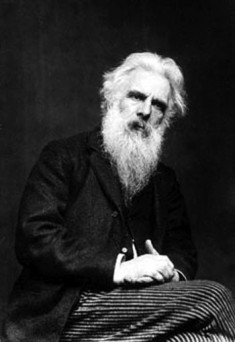| Eadweard Muybridge | |
|---|---|
 |
|
| Photographer | |
| Born | Apr. 9, 1830 Kingston upon Thames, England |
| Died | May 8, 1904 (at age 74) Kingston upon Thames, England |
| Nationality | British |
Eadweard Muybridge was a British photographer who spent much of his adult life in the United States. He was born Edward Muggeridge, but changed the spelling to what he believed was a more correct Anglo-Saxon version. He was important in the early development of motion pictures, as well as making detailed studies of animals in motion.
Muybridge came to international prominence, however, with his large-scale photographs of California’s Yosemite Valley. His personal life was complex, and included a murder trial at which he was sensationally acquitted.
Early Life
Muybridge was born in Kingston-upon-Thames, near London, on April 9, 1830. After a conventional upbringing and education, he decided to move to the United States in 1850. He first found employment as a bookseller in New York City, before moving across the country to San Francisco. It was here, in about 1855, that he became interested in photography.
It was also at this time that he chose to change his name. While on business in the east, Muybridge was badly injured in a stagecoach crash, after which he displayed noticeably eccentric behavior. He also had problems with double vision, probably as a result of the head injuries that he had received in the accident.
The Start of a Career
Once he had recovered sufficiently, Muybridge began a professional photographic career in San Francisco. He called himself “Helios” and took his equipment out to the still-wild West. As well as his famous pictures of the Yosemite Valley, he also made an important photographic study of the Tlingit people of Alaska.
His reputation was by now growing steadily, and he was asked by Leland Stanford – a former Governor of California – to help with a bet he had made. It had long been debated whether or not a horse’s legs were all airborne simultaneously when it was galloping. Stanford’s position was that they did, but there was no existing proof.
Settling a Debate
By 1872, Muybridge had begun to experiment using 12 cameras positioned in an array to take a sequence, allowing the truth or otherwise of Stanford’s position to be seen. However, his first attempts at the array were not perfect, and it took him a full decade to become certain that a running horse did indeed lift all four legs at once.
In 1883, Muybridge found a post at the University of Pennsylvania, working there for three years. During this time, he produced huge numbers of motion studies of animals and human beings. He published a series of books on the subject, and made several tours in both North America and Europe.
Suspected of Murder
Despite Muybridge’s professional success, his private life was a mess. While he had been away in California in the 1870s, his wife had been unfaithful to him. As a result, Muybridge believed that he was not the father of the couple’s child. He tracked down the other man, one Major Larkyns, and shot him to death.
His murder trial jury rejected a plea of insanity, but sensationally acquitted him, citing “justifiable homicide,” despite explicit direction from the judge that they should not do so. He remained a highly controversial figure for the rest of his life, supported by friends and attacked by enemies. He died in England on May 8, 1904.